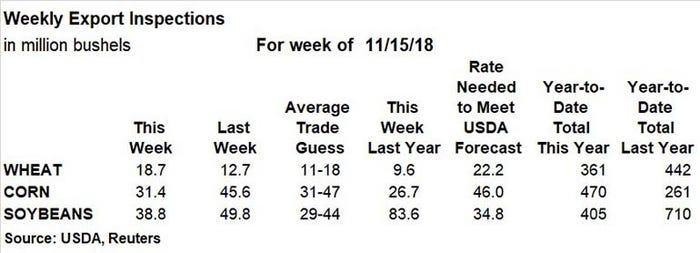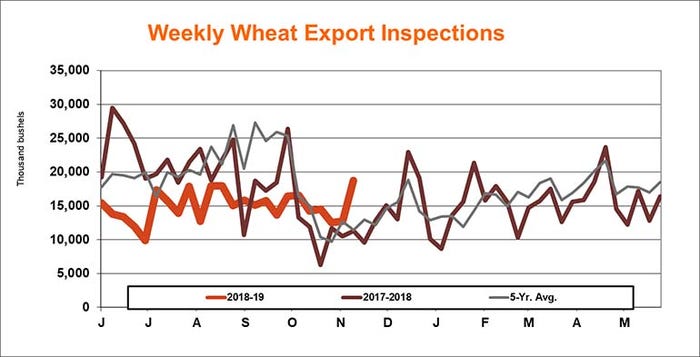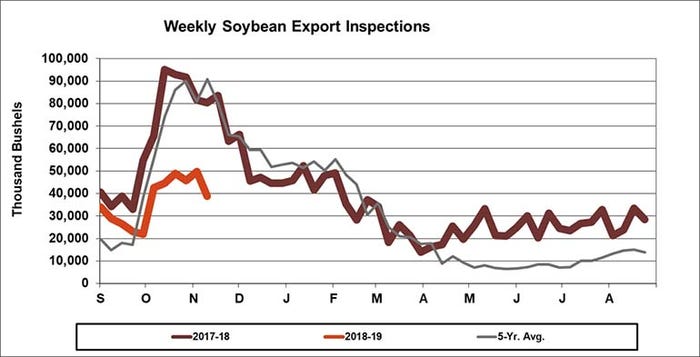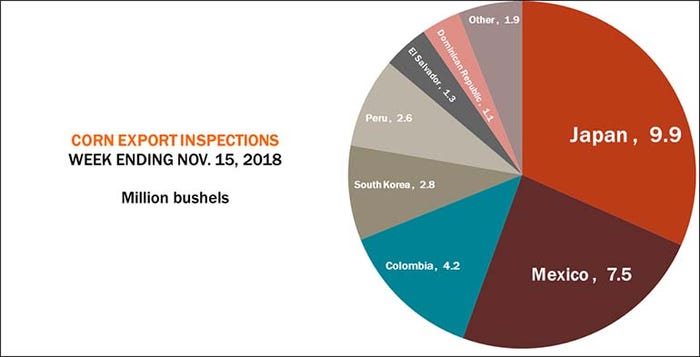Corn and soybean export inspections drop from prior week.

Grain export inspections last week again delivered a mixed round of results. Wheat posted the most positive results but remains substantially lower year-over-year. Corn and soybeans landed moderately lower than the prior week’s tally, however.

Wheat export inspections reached 18.7 million bushels for the week ending November 15, which was moderately ahead of the prior week’s total of 12.7 million bushels and just above trade expectations, which ranged between 11 million and 18 million bushels. The weekly rate needed to meet USDA forecasts moved higher, to 22. 2million bushels. Marketing year-to-date totals reached 361 million bushels, which is still more than 18% below 2017/18’s pace of 442 million bushels.
“Wheat numbers picked up a little bit, but this trend will have to continue if USDA’s forecast for the 2018 crop marketing year is to come true,” says Farm Futures senior grain market analyst Bryce Knorr. “Most of the business is to regular customers but sales to the UK and Brazil reflect lower production in those countries.”
Last week, Japan was the No. 1 destination for U.S. wheat export inspections, with 3.7 million bushels. Other top destinations included Mexico (3.1 million), Bangladesh (2.1 million), the Philippines (2.1 million) and Indonesia (1.9 million).
Corn export inspections totaled 31.4 million bushels last week, falling moderately below the prior week’s total of 45.6 million bushels and on the low end of trade estimates, which ranged between 31 million and 47 million bushels. The weekly rate needed to match USDA forecasts moved higher, to 46.0 million bushels, but cumulative totals of 470 million bushels for 2018/19 remain 80% higher year-over-year.
“Corn numbers were a bit disappointing last week – one reason we saw weaker basis at the Gulf and lower Mississippi River last week,” Knorr notes.
Japan was the No. 1 destination for U.S. corn export inspections last week, with 9.9 million bushels. Other top destinations included Mexico (7.5 million), Colombia (4.2 million), South Korea (2.8 million) and Peru (2.6 million).
Soybean export inspections totaled 38.8 million bushels last week, down from the prior week’s tally of 49.8 million bushels but on the high end of trade estimates, which ranged between 29 million and 44 million bushels. The weekly rate needed to match USDA forecasts eased slightly, to 34.8 million bushels. Cumulative totals for 2018/19 reached 405 million bushels, down nearly 43% from last year.
“Soybean inspections are still down year-on-year, but shipments held their own recently as non-Chinese buyers have nowhere else to turn for supplies,” Knorr says. “The trade dispute with China shows no signs of ending, despite some conflicting statements out of the U.S. Futures are down hard today as the cold war between the two countries got some hot rhetoric from Vice President Pence over the weekend that is also triggering a selloff on Wall Street.”
Thailand was the No. 1 destination for U.S. soybean export inspections last week, with 5.7 million bushels. Other top destinations included Argentina (5.2 million), Egypt (4.1 million), Canada (2.9 million) and Taiwan (2.9 million).






About the Author(s)
You May Also Like





